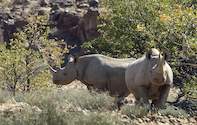
Both the desert-adapted rhinos and the welwitschia seem to prove two immutable universal laws. The first is that nature abhors a vacuum. The second is the ecological principle that every available niche will be filled, somehow, by some living thing. Often the things that fill the most extreme of niches are the most interesting: how do they manage to survive there, we ask in absolute wonderment.
As with divine justice, the wheels and cogs of evolution grind exceedingly slowly. The driving forces behind these wheels and cogs are random genetic mutation and the limitations of the environment in which organisms exist. As new traits come about in a living thing, the environment dictates which characteristics are best suited and the genes of that trait will be favoured.
Over time this process is known as "selection", but what is selecting what is open to interpretation. The only thing that is certain is that survival is more a matter of luck than predestination and that eventually, all species will go extinct: some by a natural process, but others by the hands of humankind. It should not go unnoted here that it was hunters from Europe that began the great slaughter of wildlife in Africa, usually for "sport" but also to fill museums and private collections.
Africans hunted only for food and were then declared to be poachers when colonial powers gazetted game reserves across what had previously been traditional hunting grounds. However, the slaughter of rhinos and elephants in Africa today is tied mostly to corrupt governments, either complicit or willing to turn a blind eye to crime cartels intent on plundering to the very end of the game. In poor rural areas, game guards have been found colluding with local poachers.
The scientific name of the species, Rhinoceros bicornis was originally affixed to the Indian rhino, a species even more imperiled than the African black rhino but one that has but a single horn, by Carl Linnaeus. A specimen skull of the Indian rhino had been sent to the Swedish father of taxonomy, but the collector had artificially affixed a second horn to the skull (why, it is hard to say, but maybe either for it to look more grand or bizarre than it already was, or perhaps to play a joke on the "high and mighty" man of science in his academic ivory tower at the University of Uppsala).

 Desert Rhino Camp offers one of the most exciting Namibia safaris in rugged northern Damaraland. Partnership with Save the Rhino Trust - R...
Desert Rhino Camp offers one of the most exciting Namibia safaris in rugged northern Damaraland. Partnership with Save the Rhino Trust - R...